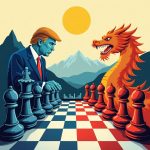In a world where technological advancements shape civilizations, China’s drone part restrictions mark a pivotal twist in our global narrative. This event, covered by Zeihan on Geopolitics, is as exciting as a plot in a blockbuster movie, only this time, the cinema is global corridors of power. Let’s dissect the cinematic grandeur of this tale that spans continents, trades, and technologies.
China's Drone Dance: A New Chapter
Picture a stage with two giants: the United States and Ukraine on one side, and China on another, egged on by Russia. Russia’s lobbying has successfully coaxed China into restricting vital drone parts, like guidance systems, motors, and batteries. Why? Because drones have become the bane of Russian military dominance. Ukraine has ingeniously started engineering these flying gadgets with rocket engines. The impact? Riveting! But as the curtain raises on this act, China's decision casts a shadow of uncertainty over this technological play.
This move is significant not just for the players involved, but for the entire global tech ecosystem. China is not merely a player; it's the world's largest producer of drone components. Imagine if Santa decided to stop delivering toys to only some kids—chaos! This will reshape the supply chain in ways we can't yet fully fathom. And for those building drones elsewhere? They'll have to scramble to find alternative parts—or better yet, start making their own.
The Pros and Cons of the Drone Ban
Let’s unravel the sticky web this ban weaves. On the surface, the embargo seems like a nuisance, forcing numerous countries, including the United States, to rethink their reliance on Chinese tech. But peel back a layer, and you'll find an opportunity as big as Hemingway's sea—a chance for reindustrialization that has been waiting in the wings like a patient understudy.
The elephant in the room isn’t just the drones. It’s those trusty battery packs that play a quintessential role in everything from electric vehicles (EVs) to energy storage. And with lithium being crucial, China's grip on battery components feels like a Jenga tower teetering on the brink. Most of the world’s lithium processing is done in China, but the ore comes mainly from Australia, Chile, and Argentina. This gives us a golden (or rather mineral) chance to bring this part of the industry closer to home—specifically, North America.
Lithium Batteries: Not Just for Your Consumer Electronics
The importance of lithium batteries transcends the consumer electronics world and includes electric vehicles, grids, and more. Transport, in my humble opinion, needs a broader base of innovation, but the grid storage possibilities are electrifying! Imagine a future where sunflower-filled Texas ranches host giant batteries soaking up the sun—not just to power EVs but to store energy and manage grid demands intelligently. With renewable energy, this is the realistic pathway to ensuring uninterrupted power supply. For a long time, the U.S. has been relying on Chinese technology, and securing our energy storage could redefine our energy landscape.
Plus, utilizing surplus energy storage curbs reliance on expensive peaker plants. These backup power plants only spring to life in rare high-demand scenarios, pulling funds from our wallets for infrastructure scarcely used. Batteries offer a compelling alternative, quietly absorbing the underutilized energy and dispatching it when calls for power ring across our lands.
The Bigger Picture: Independence and Opportunity
This could be the dawn of a reborn industrial age in North America, replete with innovative capacity-building. To adapt is to thrive, and necessity, as the adage goes, is the mother of invention. The U.S. is at a crossroads, with reindustrialization as a gateway to not just survival, but dominance in sectors like manufacturing and tech.
Even as the Chinese drone ban risks slowing progress, it simultaneously provides the wind beneath the wings for innovation de novo. Michaelangelo needed his marble. Wouldn't it be poetic justice if these political tectonics encouraged burgeoning industries and innovations right under our noses?
The global economic and technological stage is indeed in flux, and today, you are a part of the audience watching intently—as well as participants shaping it tomorrow. Are we witnessing a script filled with suspense and opportunities for growth, or a drama laced with pitfalls? The ball is in our court.
The narrative remains unwritten, characters evolving, and—here's the most exciting part—this is where you come in! What are your thoughts on the shifts within technology and international relations instigated by China's restrictions? Will North America seize this golden opportunity to innovate and minimize tech dependence on other nations?
Share your insights in the comments below and join our growing community at iNthacity: the "Shining City on the Web". Let’s continue the conversation together and dream bigger than global borders allow!
Wait! There's more...check out our fascinating short story that continues the journey: The Shadow Dancer of Xi’an
Disclaimer: This article may contain affiliate links. If you click on these links and make a purchase, we may receive a commission at no additional cost to you. Our recommendations and reviews are always independent and objective, aiming to provide you with the best information and resources.
Get Exclusive Stories, Photos, Art & Offers - Subscribe Today!


























Post Comment
You must be logged in to post a comment.